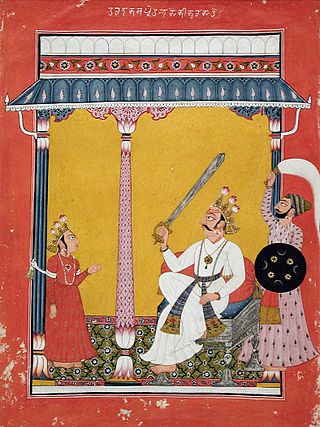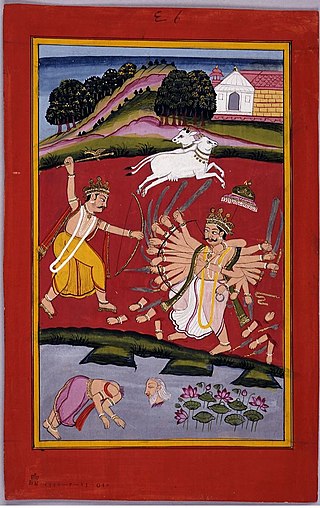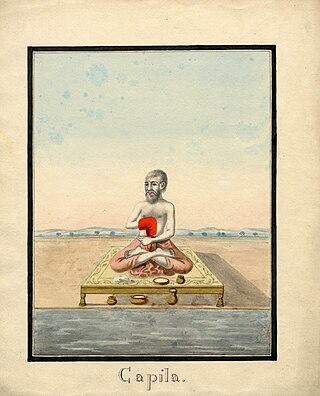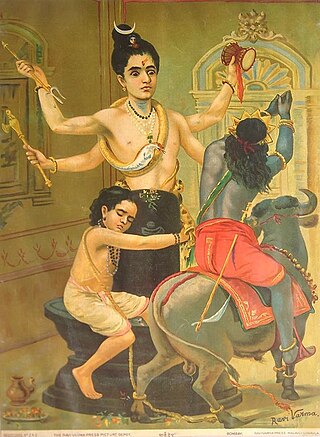Related Research Articles

In Hinduism, Daksha is one of the prajapati, the agents of creation, as well as a divine king-rishi. His iconography depicts him as a man with a stocky body and a handsome face or the head of a goat.

Hiranyakashipu, also known as Hiranyakashyap, was a daitya king of the asuras in the Puranas.

Jamadagni is a sage in Hindu literature. He is regarded in Hindu tradition to be one of the Saptarishi in the 7th, and the current age of Manvantara.

Avatar is a concept within Hinduism that in Sanskrit literally means 'descent'. It signifies the material appearance or incarnation of a powerful deity, or spirit on Earth. The relative verb to "alight, to make one's appearance" is sometimes used to refer to any guru or revered human being.

Bhrigu is a rishi of Adi-rishi tradition. He is one of the seven great sages, the Saptarshis, and one of the many Prajapatis created by Brahma. The first compiler of predictive astrology and also the author of Bhrigu Samhita, an astrological (jyotisha) classic. Bhrigu is considered a manasaputra ("mind-born-son") of Brahma. The adjectival form of the name, Bhargava, is used to refer to the descendants and the school of Bhṛgu. According to Manusmriti, Bhṛgu was a compatriot of and lived during the time of Svāyambhuva Manu, the progenitor of humanity. Along with Manu, Bhṛgu had made important contributions to the Manusmṛti, which was constituted out of a sermon to a congregation of saints in the state of Brahmavarta, after the great floods in this area. As per the Skanda Purana, Bhṛgu migrated to Bhrigukaccha, modern Bharuch, on the banks of the Narmada river in Gujarat, leaving his son Chyavana at Dhosi Hill.

Kamadhenu, also known as Surabhi, is a divine bovine-goddess described in Hinduism as the mother of all cows. She is a miraculous cow of plenty who provides her owner whatever they desire and is often portrayed as the mother of other cattle. In iconography, she is generally depicted as a white cow with a female head and breasts, the wings of a bird, and the tail of a peafowl or as a white cow containing various deities within her body. Kamadhenu is not worshipped independently as a goddess. Rather, she is honored by the Hindu veneration of cows, who are regarded as her earthly embodiments.

Kapila, also referred to as Cakradhanus, is a Vedic sage in Hindu tradition, regarded the founder of the Samkhya school of Hindu philosophy.
Manu is a term found with various meanings in Hinduism. In early texts, it refers to the archetypal man, or the first man. The Sanskrit term for 'human', मनुष्य or मानव means 'of Manu' or 'children of Manu'. In later texts, Manu is the title or name of fourteen rulers of earth, or alternatively as the head of dynasties that begin with each cyclic kalpa (aeon) when the universe is born anew. The title of the text Manusmriti uses this term as a prefix, but refers to the first Manu – Svayambhuva, the spiritual son of Brahma. In the Hindu cosmology, each kalpa consists of fourteen Manvantaras, and each Manvantara is headed by a different Manu. The current universe, is asserted to be ruled by the 7th Manu named Vaivasvata. Vaivasvata was the king of Dravida before the great flood. He was warned of the flood by the Matsya (fish) avatar of Vishnu, and built a boat that carried the Vedas, Manu's family and the seven sages to safety, helped by Matsya. The tale is repeated with variations in other texts, including the Mahabharata and a few other Puranas. It is similar to other floods such as those associated with Gilgamesh and Noah.

In Hindu scriptures, Durvasa, also known as Durvasas, is a legendary rishi (sage). He is the son of Anasuya and Atri. According to some Puranas, Durvasa is a partial avatar of Shiva, known for his short temper. Wherever he goes, he is received with great reverence by humans and devas alike.
The pitris are the spirits of departed ancestors in Hinduism. Following an individual's death, the performance of the antyesti is regarded to allow the deceased to enter Pitrloka, the abode of one's ancestors. The non-performance of these rituals is believed to result in the fate of wandering the earth as a restless preta.

Markandeya is a rishi (sage) featured in Hindu literature. He is the son of the sage Mrikanda and his wife, Manasvini. The Markandeya Purana, attributed to the sage, comprises a dialogue between Markandeya and a sage called Jaimini. A number of chapters in the Bhagavata Purana are dedicated to his conversations and prayers. He is also mentioned in the Mahabharata. Markandeya is venerated within all mainstream Hindu traditions.

Anasuya is an ascetic, and the wife of Sage Atri in Hinduism. She is the daughter of Devahuti and the Prajapati Kardama in Hindu texts. In the Ramayana, she lives with her husband in a small hermitage on the southern border of the Chitrakuta forest. A pious woman who leads an austere life, she is described as having miraculous powers.

Arundhati is the wife of the sage Vasishtha, one of the seven sages (Saptarshi) of Hinduism.

The Kumaras are four sages (rishis) from the Puranic texts of Hinduism who roam the universe as children, generally named Sanaka, Sanandana, Sanatana, and Sanatkumara. They are described as the first mind-born creations and sons of the creator-god Brahma. Born from Brahma's mind, the four Kumaras undertook lifelong vows of celibacy (brahmacharya) against the wishes of their father. They are said to wander throughout the materialistic and spiritualistic universe without any desire but with the purpose of teaching. All four brothers studied Vedas from their childhood, and always travelled together.
Besides the Ashtabharya, Krishna is described to have married several thousand women, he rescued from the demon Narakasura. The Bhagavata Purana and the Mahabharata state that 16,000 women were rescued, however the Vishnu Purana and the Harivamsa differ and set the number as 16,100. Generally all of them are unnamed, however many commentators of the Bhagavata Purana regard Rohini to be their leader, though such an explicit mention is not found in the scripture.
Kalmashapada, also known as Saudasa, Mitrasaha, and Amitrasaha is a king of the Ikshvaku dynasty In Hindu scriptures, who was cursed to be a rakshasa (demon) by the sage Vashishtha. He is described as an ancestor of Rama, the avatar of the god Vishnu and the hero of the Hindu epic Ramayana.

Sagara is a king of the Suryavamsha dynasty in Hinduism. The son of Bahuka, he ruled the city of Ayodhya, with two wives, and 60,001 sons.
In Hindu mythology, Asikni, also known as Panchajani and Virani, is a consort of Daksha in the Puranic pantheon. Most scriptures mention her as the mother of 6000 sons and 60 daughters.

In Hinduism, rivers are often personified as deities. In the Rigveda, there are mentions of holy rivers such as the Sarasvati. The river Ganges is considered to be most sacred, and is also personified as the goddess Ganga. Most of the rivers are represented in female form, with the notable exception of Brahmaputra, which is considered to be male. The most significant rivers in the faith are the Saptanadi and which includes the Ganges, Yamuna, Sindhu, Narmada, Godavari, Krishna, and Kaveri.
Svayambhuva Manu is the first of the fourteen Manus, the first man of a Yuga in Hindu cosmogony. He is the manasaputra of Brahma and husband of Shatarupa, the first woman. He is stated to have divided the Vedas into four sections.
References
- ↑ Roshen Dalal (2002), Hinduism, page 646
- ↑ Mani, Vettam (2015-01-01). Puranic Encyclopedia: A Comprehensive Work with Special Reference to the Epic and Puranic Literature. Motilal Banarsidass. p. 390. ISBN 978-81-208-0597-2.
- ↑ Dikshitar, V. R. Ramachandra (1995). The Purāṇa index. 2. (From T to M). Motilal Banarsidass Publishers. p. 327. ISBN 978-81-209-1274-8.
- ↑ Jones, Constance; Ryan, James D. (2006). Encyclopedia of Hinduism. Infobase Publishing. p. 228. ISBN 978-0-8160-7564-5.
- ↑ Hudson, D. Dennis (2008-09-25). The Body of God: An Emperor's Palace for Krishna in Eighth-Century Kanchipuram. Oxford University Press, USA. p. 388. ISBN 978-0-19-536922-9.
- ↑ The Bhagavata Purana 1. Penguin Random House India Private Limited. 2019-01-05. p. 220. ISBN 978-93-5305-378-9.
- ↑ Black, Brian; Patton, Laurie (2016-03-09). Dialogue in Early South Asian Religions: Hindu, Buddhist, and Jain Traditions. Routledge. p. 143. ISBN 978-1-317-15142-5.